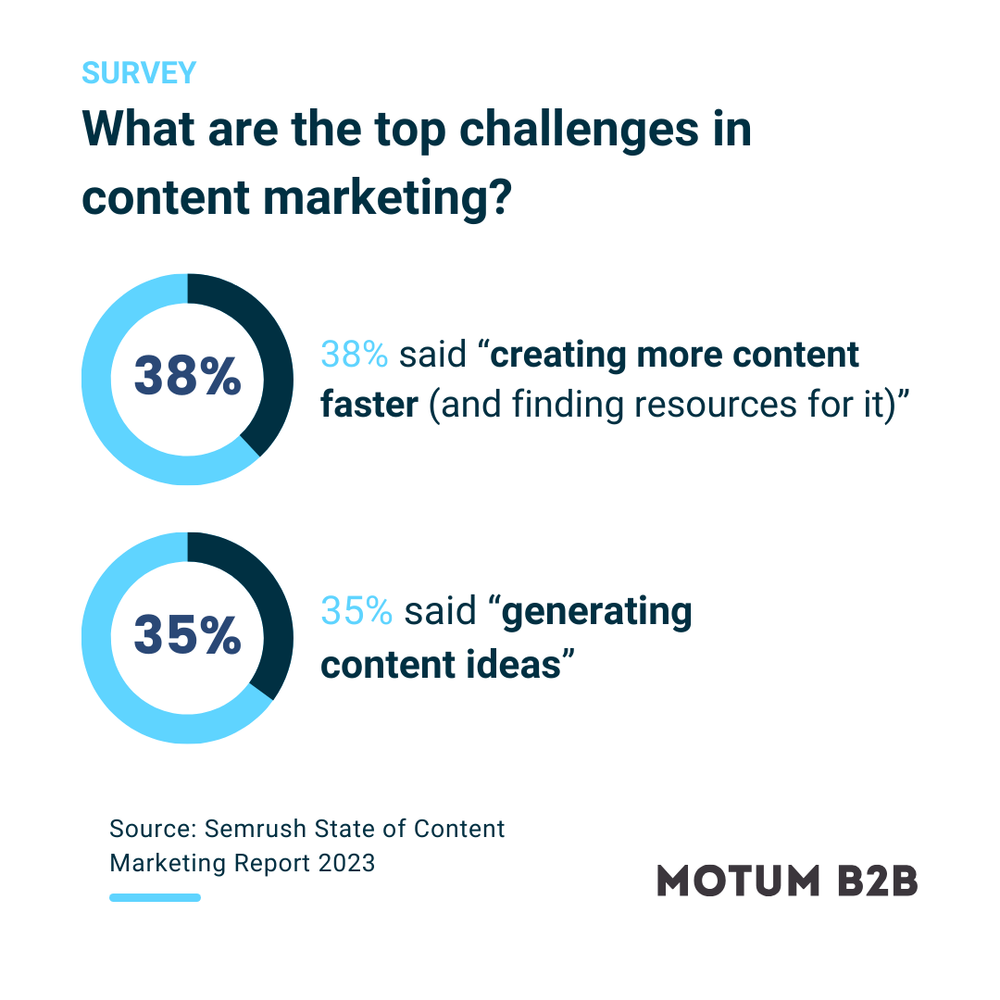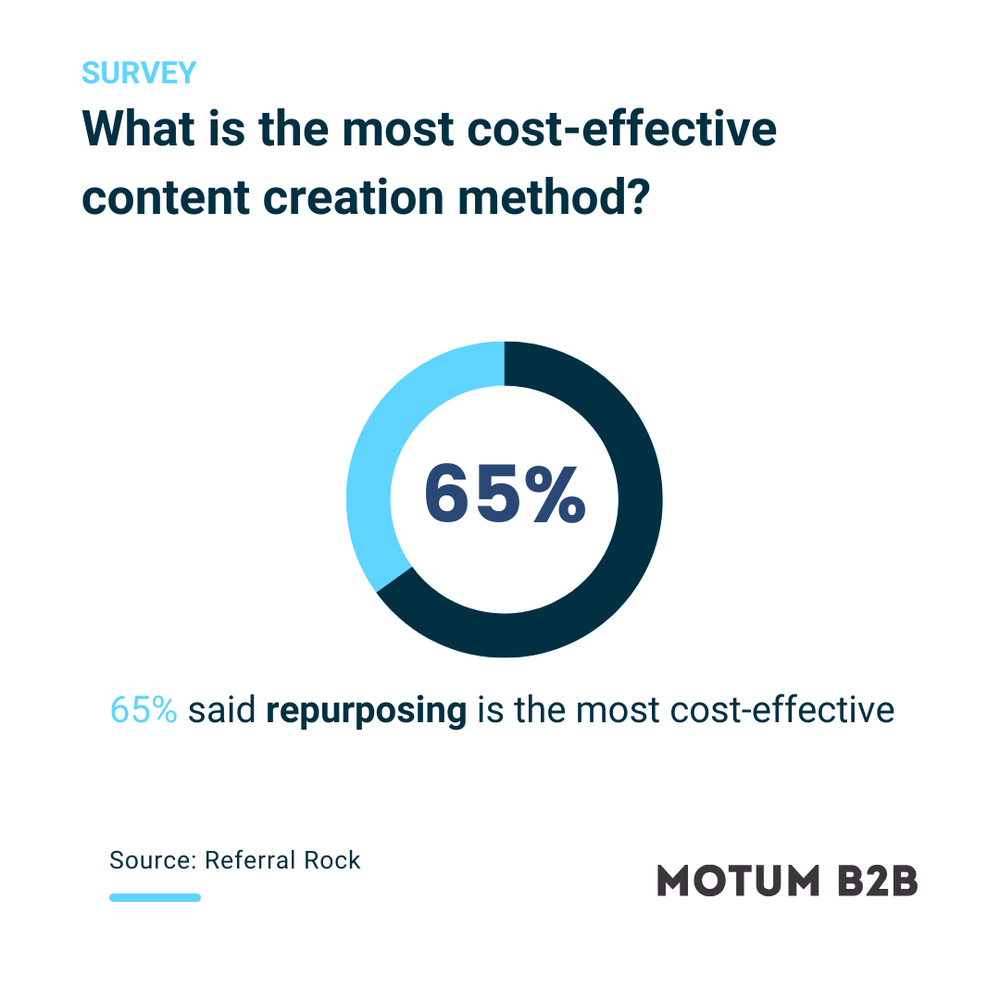How to repurpose content with purpose
Save time, diversify your content, and get more for your marketing buck with this content repurposing strategy.

Sometimes the hardest part about content creation is coming up with that first idea. Then you have to get your topic approved, research it, interview your subject matter experts… hours can pass before you’ve written a single word.
Fast-forward through the long, sometimes tedious initial steps with content repurposing.
By deriving multiple pieces of content from one source, you can save time, simplify the process of diversifying content, reach more channels, and ultimately get more mileage from each piece. You may also be able to identify gaps and opportunities for more variety in your overall content marketing strategy.
All it takes is a little shift in thinking.
Root-to-stem: A sustainable content strategy

Content repurposing is often compared to recycling, but that implies transforming one piece into something new. When you plan properly, it’s closer to the concept of root-to-stem or nose-to-tail cooking, where you use every part of the plant or animal to create a multi-course meal.
Imagine a radish: we’re used to eating only the core, but its leaves and roots can also be used. Likewise, let’s say your company makes manufacturing equipment. Maybe you have a habit of promoting one selling point of your product — let’s say it never breaks down — but don’t always get to touch on other qualities – for example, maybe workers find it easy to use in the field.
Similarly, you might say “I need to make a stew that uses this radish.” But what if you start planning that meal with the radish — root, leaves, and all? You could end up with a salad, and maybe a cup of tea, to go with your stew. Sure, you’ll need other ingredients to make it all work, but now you’re thinking root-to-stem.
When planning content, it’s common to start with the format first: “I need to write a blog that talks about my product’s durability and ease of use.” To be honest, that sounds a bit boring, and you could end up shoehorning things in just to hit your word count minimum.
Why are we talking about radishes?
Right, let’s get back to your unbreakable B2B product. Rather than thinking of content as a box you need to check off, think about how a topic or angle could work in different content formats.
To talk about your product’s durability, you could:
- Write a case study about the money it saved your client.
- Make a data chart to show how much it reduces maintenance time.
- Share an image of a customer’s quote talking about how indestructible it is.
- Film a video of someone trying (unsuccessfully) to destroy it.

A blog could get your point across, but these other options are evidence-based and visually impactful. Because they’re about the same topic, you can also plan, research, and outline them all at once.
Let’s say you already wrote the case study. Great, now use the quotes and data in there to make visuals that you can share on social media and in emails. Or maybe in your research, you found a piece of info that didn’t quite make sense to put in the case study, like a technical rep explaining how to get a longer lifespan out of your equipment. That’s a blog and an FAQ entry right there.
That’s the essence of repurposing. Hopefully you see how we’re shifting the mindset away from “I need to make a single piece of content about this topic” to “What are all the different things I can say about this topic, how are they useful to the audience, and what’s the best way to communicate and distribute each of them?”
Plan your repurpose with a source document
The easiest way to repurpose content is to start with an in-depth, long-form piece of content and break it down into smaller pieces in diverse formats. The starting piece could be a research paper, report, case study, or presentation.
If you prefer to plan it all ahead of time, create a source document with all the intel you need in one place. Start with your topic, which could be a feature or benefit of your product (e.g., durability), a concept you want customers to better understand, or a big development in your industry.

Now gather all the information you can find about that topic. Search for statistics, do your background research, and speak to your sales reps, product experts, and technical support crew. All this will go into your source document in the form of data, quotes, technical specs, product info, and anything else that will help make this a one-stop-shop for future research about your topic.
Next, plan out a series of content pieces. The goal is not to say everything from your source document in every single piece, but to tailor the message based on the format, medium, and platform.
In the end, you get more focused pieces of content that put each message in its appropriate place. You get the ability to quickly generate multiple offshoots of content without having to find new resources. And you get to distribute these to different channels, target them to different audiences, and gear them towards different points in the sales funnel.
Repurposing ideas, starting from…
…a whitepaper or research paper
Take ideas or concepts from longer written pieces of content to make multiple short blogs, emails, and FAQs. If you have data or statistics in those pieces, you can also get creative with data visualization: turn them into graphics to highlight key information and add some visual spice to the text.
…a talk or webinar
Summarize the talk and distill the main points into a list-form blog post (or several). You could create a downloadable asset — like a template, checklist, or worksheet — to accompany any of these.
…an interview with a subject matter expert
Humanize blogs with direct quotes from your expert, share videos of their Q&A answers, or populate a series of entries in your website’s FAQ section with the intel you get.
…an infographic
Break the imagery into smaller squares for a social media carousel or share them all individually via social channels or emails.
…a video
Use images from video (photos or illustrations) in assets about a related topic, like blogs or emails. You can also take short clips from the video and turn them into 3-second GIFs for social sharing.
…a blog
Turn your blog into a video script if the topic could benefit from having a human explain the more technical points, or if it could it be illustrated or expanded with visuals and voice narration.
…an FAQ
Commonly asked and searched questions are often great candidates for a blog or whitepaper. You can get them from your sales or support team, webinar Q&As, or use analytics tools to see what questions are being searched about your product or service, then turn them into almost anything.
…a set of illustrations
Plan multiple visual assets from the same set of illustrations, like we did with this digital interactive, video, and landing page collateral.
Repurpose with purpose
As you can imagine, one act of repurposing can set off a whole chain of awesome content at a fraction of the effort. You can do it with almost anything.
Remember not to use a copy-and-paste approach — don’t duplicate content or reuse the exact same wording. You still have to adapt each piece to the medium, format, and platform to make it feel original and fresh.
There’s a lot to keep in mind, but experienced content marketers can help.
Want to find your (re)purpose?
To turn your marketing goals into actionable ideas, partner with our content experts.